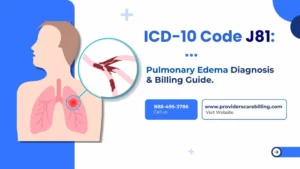Getting CPT codes correct in behavioral health billing is critical for compliance and reimbursement, not merely an administrative duty. Their understanding, or lack thereof, often results in denial, underpayment, or an audit stemming from improper billing. Is it underwritten or overcomplicated? With two of the most common codes, 90832 and 90833, confusion is created without careful handling.
Both codes serve as indicators of completing a 30-minute psychotherapy session; the difference between them is the way of use and who uses them. Simplified, understanding the distinction between CPT 90832 and 90833 is a major concern for therapists, psychiatrists, and mental health billing staff.
This article will elaborate on the meanings and guidelines associated with each code, along with steps to lessen incorrect billing procedures.
What is CPT Code 90832?
90832 CPT code only billed for psychotherapy lasting for 16-37 minutes. Face-to-face psychotherapy is the only type offered by therapists with this specific code interval on someone’s record. In contrast to overlapping codes, it has none in its group, giving it the title of stand-alone code, to be billed separately, which means no need for an E/M code or any counterpart.
Key Features
· Duration: 16-37 minutes
· Type: Individual psychotherapy (face-to-face)
· Providers: Therapists, psychologists, psychiatrists
Common uses
Counseling, talk therapy, and CBT sessions which do not consist of medical evaluations.
In the 90832 CPT code description, it is noted that this service includes a therapeutic chat with the patient, which frequently contains some cognitive, behavioral, or emotional treatment. It is often seen in outpatient services, and most often it is reimbursed for by people who do not treat or manage the physical components of health, which would include licensed professional counselors and clinical social workers.
What is CPT Code 90833?
The 90833 CPT code has the same reporting as 90832 for psychotherapy for sessions lasting between 16 and 37 minutes. But the 90833 is an add-on code. It cannot be billed by itself. It always has to be combined with some E/M code, in this case, e.g. 99214 or 99213
Who Uses It?
· Psychiatrists
· Psychiatric Nurse Practitioners (NPs)
· Physician Assistants
This code covers both therapy sessions and medication management as well. This makes the 90833 CPT code reimbursement suitable for a combined practice.
Example from Practice:
A psychiatrist reviews a patient’s medication therapy, makes improvements in it, and also provides therapy for half an hour. The diagnosis encountered during this appointment was indeed the one the doctor was treating the patient. The correct billing in this situation is:
· E/M code (e.g., 99213) for the med management
· CPT 90833 for the psychotherapy portion
The 90833 CPT code explanation explains that it is an add-on code that cannot be used without mentioning any E/M code. Or we can say it’s not a stand-alone code.
Comparison Table: 90832 vs 90833
| Feature | CPT 90832 | 90833 CPT code |
| Type | Psychotherapy only | Psychotherapy + E/M |
| Duration | 16–37 minutes | 16–37 minutes |
| E/M Required? | No | Yes |
| Standalone? | Yes | No (Add-on only) |
| Used By | Therapists, psychologists, and psychiatrists | Psychiatrists, NPs, PAs (with E/M) |
This table highlights the main difference between the two codes. The first one can be used without any E/M component, but the last one (code 90833) cannot be used without any primary code, e.g., E/M code.
When To Use Each Code
Use CPT 90832 if:
· You are a therapist or psychologist who does not prescribe medications.
· Your session is purely related to mental health therapy
· If the therapy continues for 16 to 37 minutes.
Use CPT 90833 if:
· You are a psychiatrist or psychiatric nurse practitioner who prescribes medications.
· Perform both medical and therapy sessions in one visit.
· Your documentation supports both therapy and the E/M components separately.
Documentation Tips
· Time spent on therapy versus the medical management should be categorized separately.
· Explain in detail both services provided: symptoms considered, changes in medication, and therapeutic interventions applied.
· Note that the lack of detail should be avoided because insurers need specific and medically necessary evidence for both the E/M and psychotherapy.
Common Billing Mistakes
Among the top reasons claims get rejected is billing behavioral health codes incorrectly. Other frequent errors seen with 90832 and 90833 include:
Claiming 90833 without an E/M code.
90833 cannot be claimed alone. It should be paired with a code such as 99213 or 99214.
Billing 90832 and 90833 together
Codes 90833 and 90832 cannot be billed together for one patient on the same date.
Under Documentation
Under-documenting time or not properly separating E/M and therapy notes could result in an audit or denial. Be specific and complete.
Related Codes You Should Know
CPT code 90839
Used for psychotherapy for sessions of mid-length, 30 to 74 minutes. This cannot be mixed with the more general codes 90832 and 90833, which are used for 30-minute therapy.
90836 CPT code
This code can be used for 45-minute psychotherapy in combination with an E/M service. It is like the 90833 codes but for longer intervals, so more time is spent during the session.
Group psychotherapy CPT code
Group therapy CPT code 90853 is used when multiple patients are being treated simultaneously.
CPT 99484
The code for collaborative care management in team-based mental and primary care.
If you’re in the medical billing or radiology field, you might also find our breakdown of CPT Code 73721 vs 73723 useful—it covers key differences in MRI lower extremity imaging that impact reimbursement and coding accuracy.
Conclusion
The decision to choose between 90832 and 90833 is summarized as follows:
· Put CPT 90832 for therapy sessions that are not integrated with other services
· Put CPT 90833 with an E/M code when therapy is done in the same visit
Ensuring precise claim coding mitigates billing inaccuracies and safeguards your practice against audits. Whether assuming medication responsibility, delivering CBT, or documenting a crisis session with CPT 90839, always align your service with the corresponding code.
Each insurance policy is unique, so clearing up precisely what is needed or what steps to take regarding specific coding guidelines is crucial. A medical biller may alleviate any frustrations and increase productivity within the organization. A person well skilled in CPT codes and policies, rules around insurance, and handling denied claims can maintain the financial health and compliance of your practice.




